It’s always useful to write about the embroidery and needlework products that one is interested in! I actually never have any “mercenary” motives when I write about the things I like – but I did manage to land a nice needlework kit for my birthday this year – the Bayeux kit I mentioned when I told you about the French Needle!
So, here I am, musing over this kit. The kit allows the needleworker to recreate a small section of the famous Bayeux tapestry – and I’ve since learned that there are many of these kits available, featuring different parts of the tapestry. I like the one I received, and I think I’d also like (eventually) one with ships on it. BUT – that remains to be seen! I’ll let you know if those sentiments change after working this kit!
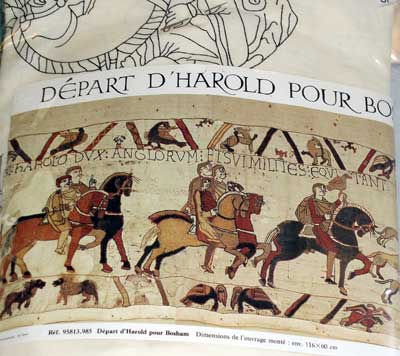
This is the kit I received. You can see at the top of the picture the design printed on the fabric. The fabric is a sturdy cotton, and all the lines of the design are printed on it in black. In fact, it’s a lot like an almost-cartoonish-looking linedrawing of this section of the tapestry, and it looks strange in just lines – until you realize that it really is exactly what the tapestry looks like, minus the colors!
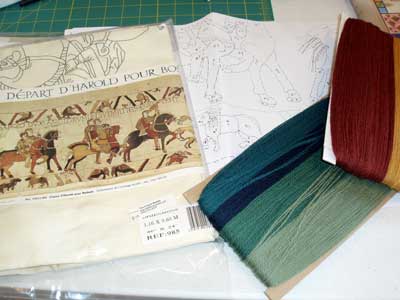
Besides the printed fabric, the kit contains wool for embroidering (seems about the weight of crewel wool, maybe slightly heavier) and a chart of the embroidery project, indicating what colors go where.
Note: there are no stitch instructions, really. The whole piece is supposed to be worked in Bayeux stitch, which is a laid and couched stitch. Even though there are no stitch isntructions, the kit should be pretty easy to work! Time consuming, but fairly simple.
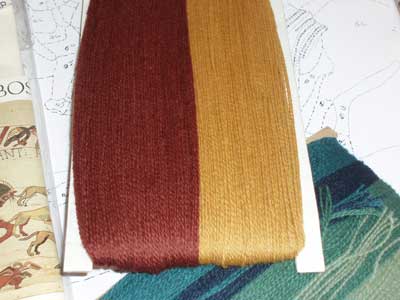
What struck me as strange was the limit of browns. In fact, for the elements in the tapestry that seem “brownish,” there is only one brown and one rust color. There’s also a navy blue – apparently, some the horses are to be worked in navy blue.
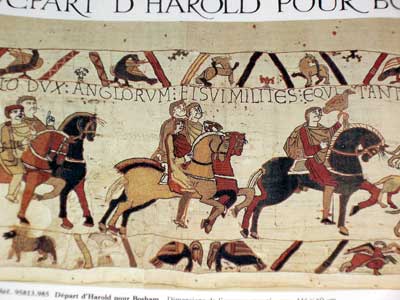
See the dark horses? They look black to me, but apparently, they are navy blue. Check out their red legs!
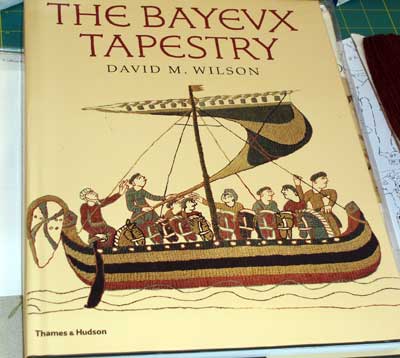
Well, to get some better insight into the project before undertaking it, I thought I would drag out David Wilson’s book on the Bayeux Tapestry. It’s a nice book – besides getting the history of the tapestry and the story translated and explained, you also get very close up images of the entire tapestry.
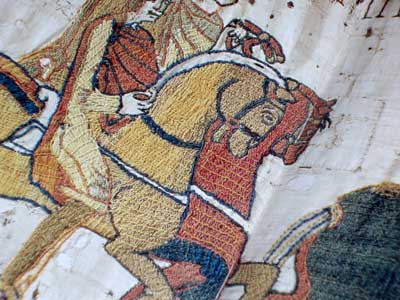
And, in fact, in opening the book to the pages corresponding to my kit, I found a very helpful resource for working this kit. The individual threads and stitches are crystal clear! You can even see that the blue is really blue. Notice the color changes in the work. Apparently, the stitchers weren’t too concerned about color changes. When their thread ran out, it is surmised, they merely took up another color.
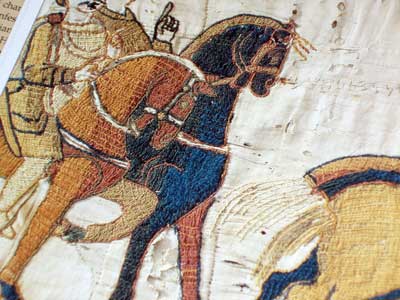
And the colors didn’t always match, even if they were the same.
Still, it seems to me that in this section, there is at least one more shade of a tannish brown color. I suppose that could have come about from fading and what-have-you, but even so, I’m thinking I might invest in one more color of thread before I work this kit.
In the original tapestry, no more than 8 colors are used throughout the whole piece. But I would imagine that dye lots would have provided slight variations within the colors, whether these variations were desirable or not.
I love the kit, and am looking forward to working on it … some day! In the meantime, I’ll keep an eye out for the opportunity to go thread shopping in person, to see if I can come up with one more compatible shade of tannish-brown.
If you want to see what the Bayeux Stitch is, you can check out this video tutorial on Bayeux stitch, with information on kits and so forth from Bayeux Broderie on Vimeo.
If you’re interested in these kits, you can find them at The French Needle – and if you want to order a different scene of the tapestry, you can contact The French Needle to find out what other scenes are available. Also, if you read my previous post about the French Needle, you can find out how to save 10% on any order during April.







Oh – your project sounds fun! Thanks for the links!
I have a project that makes use of the DMC medici threads, too, but now I need to find another thread that I can substitute. Any suggestions for a good substitution?
Thanks!
MC
Looks like an interesting kit. I’ll say I’m disappointed in the use of cotton instead of linen as the original. Is it produced at original size? Did they say what brand of thread is included?
The thread used would be a “crewel” weight, like the Medicis. I recently did a review of several threads to determine what else to use. I’ve placed a link to the paper I wrote on my “embroidery sharing” webpage: http://sites.google.com/site/elizabetembroidery/Home/research-paper
I’m also planning a large Bayeux inspired piece. For mine, I’ve used the Wilson book to select figures, but have rearranged them for my own picture. That goes on the slate frame soon…
The best guide on the bayeux stitch is a pdf by Racaire. You might also want to check out her embroidery using a similar technique in her blog. It is beautiful.
I also have that book and plan on doing my own version one day, drawing up the section I choose to do. I started collecting the DMC medici range of threads just before they stopped producing them. Such a pity!
Mary, welcome to the glutton for punishment club, Bayeux Tapestry chapter! As I mentioned in a comment on an earlier post I have this same kit (or very similar) and it’s HUGE! I do want to stitch it someday, but I know that doing the same stitch over and over and over is going to drive me crazy so I’m waiting for the right moment to tackle this project.
As for DMC Medici alternatives, how about Heathway crewel yarn? Appleton is nice, but it always seems kind of ‘furry’ to me. I really liked Medici, it was smooth and there was certain ‘cleanness’ that I liked in the finished product. I just tried some Heathway on the Fair Maiden Sewing Purse from Sampler & Antique Needlework. It worked nicely and I really like how soft it is. (I don’t know why, but I really like soft crewel yarn and Appleton doesn’t do it for me on that score.) Heathway is being sold in the States by Tristan Brooks whose website is pretty much non-functional at the moment. I have yet to find another source for Heathway. I would like to see a shade card as I don’t know the extent of Heathway’s colour range.
The sewing purse project used a nice range of colours so I got to try a little bit of shading. I really liked working with the Heathway. I had no problems with shredding and I use fairly long lengths of thread/yarn when stitching. I also didn’t find it ‘furry’. I look forward to using it again.
Ah, thanks so much for the information, ladies! I dont’ know too much about wools – I’ve used quite a few wool / silk blends, and lots of Appleton crewel wool (which I characterize as “scratchy”) but haven’t really ventured out to find other 100% wool threads similar to Appleton. The Heathway threads sound intriguing…
It’s great to be able to order threads online, but for this, I’d really like to see the threads up close.
The kit is interesting, but it’s rather simple. There are no instructions, really – just the assumption that the stitcher will know what to do.
I’m not sure what type of threads they are – it doesn’t indicate the brand of wool. But they don’t seem quite as “scratchy” as Appleton. I’m thinking they also seem just slightly thicker than Appleton. I need to take out a skein of Appleton in a similar color and compare, to see for sure, though.
I enjoyed reading the article, Elizabet – very interesting search for threads! And funny how each one is so decidedly different.
Thanks again for your help! I really appreciate it!
That looks like quite the fun challenge, particularly for my largely-beginner embroidery skills! It’s certainly on my “some day” project list. Good luck!
Good luck for your project 🙂
…btw. some of the colour changes inside a section are also the result of “repair work” done in later times – the book of David M. Wilson refers to the colours of light yellow, orange and light green for repair work.
Best regards from Vienna
Racaire
Mary, in response to yours (comment 2), I unfortunately haven’t found a substitute I like as yet. Appleton, while similar in colour range seems to be more delecate and prone to weak spots and breakages. I believe Paterna also does a crewel weight range, but I think it was a little thicker.
http://www.renaissancedyeing.com/ is where Racaire (who I mentioned last time) got her wool, however I haven’t had experience with that seller and it is all naturally dyed so more prone to bugs eating the lovely threads.
If you find anything that weighs up against the DMC Medici I would love to know.
I hope this is still an active thread. I am interested in doing a figure or two and wonder how tall a typical human is on the original tapestry? Is it about 4 inches? How large are the figures on the kits? Thanks for your help!
Hi there. I just went on Wikipedia for Bayeaux Tapestry and there is a picture that makes the color divisions look very clear, just thought I’d mention!
Thanks! Just took a look – nice photo!
Best,
MC
Have just been to Bayeux, had a class at the local shop with Chantal James. Wonderful to see the work up close and all the repairs too!
Chantal has the wool made especially for her kits and she sells the hanks as well…
http://www.bayeux-broderie.com/
I am not sure if she sells the linen – would be a shame to stitch this work on cotton as it might not have the strength to carry the weight of the stitches…
Good luck
Michelle
This is a really interesting post, thank you. I’m just about to try designing my own bit of work but want to use laid work and couching for speed. I haven’t done it before but I’m looking forward to having a shot. Good luck with this kit and thank you for sharing your findings, it has saved me a bit of searching.
Many thanks
The French Needle advertises this kit as linen-are you sure its cotton?
Hi, Christine – Yes, the one I have is cotton. I’m not sure why the difference. You may wish to contact the French Needle and make sure before you order. I’ve seen them listed as “linen” but I don’t know if there is another company that produces some in cotton, or what. But I’m 99.9% sure mine is cotton. I’ll dig it out and see if it’s on the label as cotton – I think that’s where I got the original information! ~MC
Hi. Not sure if this topic is still going on but I would like any help as to what frame to use for my 50cm high x 1.8m long Bayeux tapestry I am about to attempt (bought it in Bayeux years ago). I can’t use a normal frame as it is very wide/long. Could I just use a large hoop and move it around or would a permanent frame be better? Any suggestioins would be appreciated. Tx.
Are you finished your embroidery? Have you questions to ask me? The various colors of wools are often due to the restoration or the bad exhibition of the embroidery. Specialized on this technique of embroidery, I have a special authorization of reproduction on all of the Bayeux Tapestry. My kits always are as the original in linen and wool to specially realized for my professional workshop at Bayeux (French). I market the wool and the linen separately on my site.
regards chantal james
avez vous fini votre broderie ? avez vous des questions à me poser ? les différentes couleurs de laines sont souvent dues à la restauration ou mauvaise exposition de la toile. spécialisée sur cette technique de broderie, j’ai une autorisation spéciale de reproduction sur la totalité de la tapisserie de bayeux. mes kits sont toujours comme l’original en toile de lin et laine à broder spécialement réalisée pour mon atelier professionnel. je commercialise la laine et le lin séparément sur mon site.
what kind of needles did they use. the wool is quite fine was it a gold material
I use embroidery needles with a good quality the brand “bohin”
On this page you have reference to Bayeux Stitch, Ancient and Modern (PDF) Unfortunately, that link no longer works. I’m informed that this page is no longer on that server. Do you know what happened, and where I might be able to find the instructions for the Bayeux stitch? I have just returned from France, and saw the Bayeux Tapestry, and bought a kit of a boat scene at the Bayeux Broidery store just around the corner from the tapestry building. Years ago I did cross-stitch. Since then I have become a weaver mostly of rugs and towels, but lately have become interested in embroidery. I have a simple kit to begin with before tackling the Bayeux. But, if you can correct that link, or make the pdf available, I would appreciate it. There’s no urgency on this matter. I have this other project to finish first.
Hi, Bob – I’m not able to find that PDF online right now. Not sure where it went! In the meantime I’ve replaced that link with a video tutorial from Bayeux Broderie on the technique. Thanks for alerting me to the missing PDF!
There are directions for the bayeux stitch on Chantal’s Bayeux Broidery website.
Hello, just for posterity in case anyone is interested, this company, in Bayeux itself, is the ultimate source for these kits, of which I think French Needle only carries a selection.
I would love to be able to order an embroidery kit like this…where did you find that at?
Hi Mary,
Did you finish stitching this piece? I have the same kit, though it does have instructions. Well a chart with colours, anyway. My kit is stamped “Princesse” and seems to be knitted the same way.
I was concerned the fabric was too light to hold the stitched and was thinking of lining it with muslin to give it more body. What do you think?
Best regards
Mary-Anne
I never did finish it. In fact, I never properly got it underway. Yes, I think you could back it with muslin, not a problem! It would probably be a good idea, just to give it that extra support with the dense stitching.